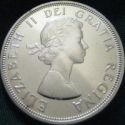
Queen Elizabeth II
Canadian Commemorative
Silver Dollars
You will find more buying and selling information on 29 of the most popular Canadian 80% silver coins in my eBook The Last Canadian 80 Percent Silver Coins. Read the first few chapters free.
The image of Queen Elizabeth II first appeared on the Canadian dollar in 1953, replacing that of King George VI whose image appeared from 1937 through 1952 (the year of his death). The Queen's image appears on Canadian dollars to this day although a number of modifications have been made throughout the years plus the removal of all silver from the coins minted for circulation (Business Strikes) beginning in 1968.
Three Queen Elizabeth II commemorative silver dollars were struck
between 1953 and 1967: the 1958 British Columbia Commemorative
Dollar; the 1964 Confederation Meetings Commemorative Dollar; and
the 1967 Confederation Centennial Commemorative Dollar. Here are
their details ...
1958 British Columbia Commemorative Canadian Dollar
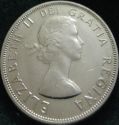 This silver dollar commemorates the centennial of the
establishment of British Columbia as a crown colony. The obverse
features the image of a youthful Queen with laurel wreath and the
inscription Elizabeth II Dei Gratia ("God's Grace" also referred
to as "by the grace of God") and Regina (Queen).
This silver dollar commemorates the centennial of the
establishment of British Columbia as a crown colony. The obverse
features the image of a youthful Queen with laurel wreath and the
inscription Elizabeth II Dei Gratia ("God's Grace" also referred
to as "by the grace of God") and Regina (Queen).
The reverse has the image of a totem pole (artistry associated
with this region of Canada) with the Rocky Mountains in the
background and dual dates of 1858 and 1958, CANADA as the issuing
country and the denomination of (1) DOLLAR. Click on either image
for a larger view.
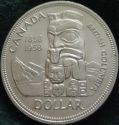
A total of 3,039,630 British Columbia Silver Dollars were minted which includes the higher-grade Prooflike Strikes.
The 1958 British Columbia Commemorative Silver Dollar (and all Canadian silver dollars minted from 1935 through 1967) are 80% silver and 20% copper. Silver content/silver fineness is .600 troy ounces although a well worn coin will contain less.
To determine the intrinsic
(silver melt) value of a 1958 Canadian dollar multiply .6
times the current spot price of silver.
Example: CAD $40.00 x .6 = $24.00
1964 Confederation Meetings Commemorative Dollar
This dollar commemorates the centennial of the conferences held with various Canadian entities which resulted in Canada's confederation in 1867. The obverse features the image of a youthful Queen with laurel wreath and Dei Gratia ("God's Grace" also referred to as "by the grace of God") spelled out.
The reverse has the dual dates of 1864-1964, the dollar denomination and a unique center design which consists of a circle featuring an English rose, Scottish thistle, Irish shamrock and French fleur-de-lis surrounded by the two meeting locations of Charlottetown, Prince Edward Island and Quebec City, Quebec. Click on either image for a larger view.
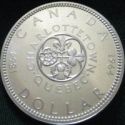
A total of 7,296,832 Confederation Meetings Silver Dollars were minted which includes the higher-grade Specimen/Prooflike Strike Dollars.
1967 Confederation Centennial Commemorative Dollar
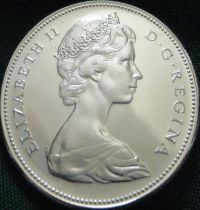 The 1967 silver dollar commemorates the 100 year anniversary of
the Canadian Confederation - the process by which the federal
Dominion of Canada was formed from the provinces, colonies and
territories of British North America. It is the last of Canada's
circulating silver dollars. The obverse features the image of a
mature Queen Elizabeth wearing a jeweled tiara - a design that was
introduced in 1965 as the queen neared the age of 40.
The 1967 silver dollar commemorates the 100 year anniversary of
the Canadian Confederation - the process by which the federal
Dominion of Canada was formed from the provinces, colonies and
territories of British North America. It is the last of Canada's
circulating silver dollars. The obverse features the image of a
mature Queen Elizabeth wearing a jeweled tiara - a design that was
introduced in 1965 as the queen neared the age of 40.
The reverse is that of a Canada goose in flight ( a wildlife theme was used on the reverse of all 1967 commemorative coins) with the dual dates of 1867-1967 and the denomination. Click on either image for a larger view.
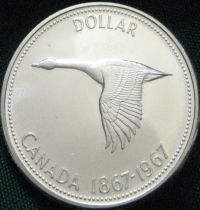
A total of 6,767,496 Confederation Centennial Silver Dollars were minted which includes the higher-grade Specimen/Prooflike Strike Dollars.
The 1967 Confederation Centennial Commemorative Silver Dollar is the last of Canada's circulating dollars to contain silver (80% silver and 20% copper.) Silver content/silver fineness is .600 troy ounces although a well worn coin will contain less.
To determine the intrinsic (silver
melt) value of a 1967 Canadian dollar multiply .6 times the
current spot price of silver.
Example: USD $30.00 x .6 = $18.00
If you are shopping for these commemorative coins and live in
Canada, a likely starting point for your purchases would be at
your local coin shop or even area coin shows. If you are a U.S.
citizen or a Canadian visiting the U.S., you may have better luck
at coin shops or shows in one of the states bordering Canada. I
have found coin shops further south of the Canadian border are a
"little light" on their knowledge and inventory of Canadian coins.
Good luck.
Disclaimer: I have made every reasonable effort to produce an informative and helpful article on Queen Elizabeth II Commemorative Silver Canadian Dollars based on my research and experiences. However, I make no representation or warranties of any kind with regard to its completeness, accuracy or suitability for any specific situation or purpose. See Terms and Conditions for more info.
